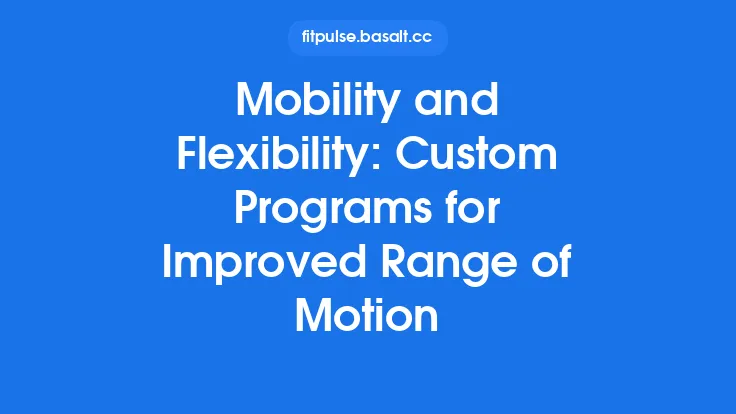Evening mobility work is often overlooked in favor of more “active” parts of the day, yet it plays a pivotal role in how the body recovers from daily stresses and prepares for restorative sleep. By deliberately moving through a sequence of controlled, low‑intensity patterns at the end of the day, you can reduce residual muscle tension, improve joint lubrication, and reinforce the neural pathways that support long‑term flexibility. This article walks you through the science‑backed rationale, the essential components, and a step‑by‑step flow that can be incorporated into any evening routine without requiring special equipment or extensive time commitments.
Why an Evening Mobility Flow Matters
- Facilitates Parasympathetic Activation
After a day of sympathetic dominance (the “fight‑or‑flight” response), a gentle mobility flow signals the nervous system to shift toward parasympathetic tone. This transition lowers heart rate, reduces cortisol levels, and primes the body for deep, restorative sleep.
- Promotes Synovial Fluid Distribution
Joint capsules rely on movement to circulate synovial fluid, which nourishes cartilage and removes metabolic waste. Evening mobility ensures that each joint receives a final “flush” before the body becomes largely immobile during sleep.
- Mitigates Accumulated Micro‑Trauma
Repetitive tasks—typing, driving, lifting—create microscopic strain patterns in muscles and fascia. A targeted flow can gently “reset” these patterns, preventing the buildup of adhesions that would otherwise limit range of motion over time.
- Supports Musculoskeletal Homeostasis
By moving through full‑range, low‑load patterns, you reinforce proprioceptive feedback loops. This helps maintain balanced tension across agonist‑antagonist pairs, reducing the risk of postural imbalances that often manifest after prolonged sitting.
Core Principles of an Evening Routine
| Principle | Description | Practical Implication |
|---|---|---|
| Low‑Intensity, High‑Control | Movements should be performed at a comfortable pace with an emphasis on joint articulation rather than muscular force. | Avoid heavy loading; focus on smooth, fluid transitions. |
| Breath‑Coupled Motion | Synchronize inhalation and exhalation with specific phases of each movement to enhance relaxation. | Use diaphragmatic breathing; inhale during opening phases, exhale during closing phases. |
| Progressive Joint Sequencing | Begin with proximal (core, hips) and move distally (shoulders, wrists) to respect the body’s kinetic chain hierarchy. | Start with hip circles, then thoracic rotations, ending with wrist mobility. |
| Balanced Antagonist Work | Pair each agonist‑dominant movement with its antagonist to maintain muscular equilibrium. | Follow a hip flexor stretch with a hip extensor activation. |
| Time‑Under‑Tension (TUT) Management | Hold each position long enough to stimulate connective tissue remodeling (typically 3–5 seconds) but not so long that fatigue sets in. | Use a timer or count silently to maintain consistency. |
Structuring the Session: Duration, Order, and Intensity
- Total Duration: 15–25 minutes. This window is sufficient to address major joint groups without encroaching on bedtime.
- Order of Segments:
- Grounding Breathwork (2 min) – Establish parasympathetic tone.
- Global Joint Warm‑Up (3 min) – Light, dynamic circles for spine, hips, shoulders.
- Targeted Mobility Flow (10–15 min) – Structured sequence (see detailed flow below).
- Myofascial Release (optional, 3–5 min) – Light self‑myofascial work using a ball or roller.
- Relaxation & Visualization (2 min) – End with a brief body scan to cement the calm state.
- Intensity Guidelines:
- Perceived Exertion: 2–3 on a 10‑point scale (very light).
- Range of Motion: Move to the point of mild stretch, never to pain.
- Muscle Activation: Minimal; focus on joint capsule movement rather than muscular contraction.
Detailed Evening Flow Sequence
Below is a comprehensive, joint‑centric flow that can be performed on a yoga mat or carpeted floor. Each movement is described with cueing, duration, and the primary structures addressed.
1. Diaphragmatic Reset (2 × 30 sec)
- Position: Supine, knees bent, feet flat.
- Action: Place one hand on the belly, the other on the rib cage. Inhale deeply through the nose, allowing the belly to rise; exhale slowly through the mouth, feeling the ribs contract.
- Purpose: Activates the diaphragm, reduces thoracic tension, and primes the nervous system for relaxation.
2. Pelvic Clock (3 × 30 sec)
- Position: Supine, legs extended, arms relaxed at sides.
- Action: Visualize a clock on the pelvis. Gently tilt the pelvis forward (12 o’clock) and backward (6 o’clock), then side‑to‑side (3 & 9 o’clock). Keep movements small and controlled.
- Structures Targeted: Lumbar spine, sacroiliac joints, hip flexors/extensors.
3. Supine Thoracic Windmills (2 × 45 sec)
- Position: Supine, arms outstretched in a “T”.
- Action: Drop both knees to one side while keeping shoulders grounded, then return to center and repeat to the opposite side. Maintain a slow, fluid motion.
- Structures Targeted: Thoracic vertebrae, intercostal muscles, scapular stabilizers.
4. Hip 90/90 Mobilization (2 × 45 sec per side)
- Position: Seated, front leg bent at 90°, back leg extended at 90°.
- Action: Place hands on the front knee, gently press forward while maintaining an upright torso. Then, rotate the torso toward the back leg, opening the hip capsule.
- Structures Targeted: Hip internal/external rotators, gluteus medius, adductors.
5. Scapular Wall Slides (3 × 30 sec)
- Position: Standing with back against a wall, elbows at 90°, forearms against the wall.
- Action: Slide arms upward, maintaining contact with the wall, then lower back down. Keep shoulders depressed and scapulae moving smoothly.
- Structures Targeted: Scapulothoracic articulation, rotator cuff, posterior deltoid.
6. Ankle Rockers (2 × 45 sec per foot)
- Position: Kneeling on one knee, other foot flat on the floor.
- Action: Rock the front foot forward, allowing the ankle to dorsiflex, then rock back, encouraging plantarflexion. Keep the knee aligned over the ankle.
- Structures Targeted: Ankle joint capsule, tibialis anterior, gastrocnemius‑soleus complex.
7. Wrist Flexor‑Extensor Flow (2 × 30 sec per side)
- Position: Kneeling, palms together in prayer position.
- Action: Slowly separate the palms, allowing the wrists to extend, then bring them back together, flexing the wrists. Perform the motion symmetrically.
- Structures Targeted: Radiocarpal joint, flexor and extensor muscle groups.
8. Full‑Body Cat‑Cow with Hip Emphasis (3 × 45 sec)
- Position: Quadruped, hands under shoulders, knees under hips.
- Action: Inhale, drop the belly, lift the tailbone and head (Cow). Exhale, round the spine, tuck the tailbone, and gently draw the hips under the shoulders (Cat). Emphasize a subtle hip hinge on each transition.
- Structures Targeted: Lumbar spine, sacroiliac joints, thoracic mobility.
9. Supine Figure‑Four Stretch (2 × 30 sec per side)
- Position: Supine, right ankle crossed over left knee.
- Action: Gently pull the left thigh toward the chest, feeling a stretch in the right gluteus maximus and piriformis. Hold, then switch sides.
- Structures Targeted: Hip external rotators, gluteal muscles, piriformis.
10. Closing Body Scan (2 min)
- Position: Supine, arms relaxed.
- Action: Mentally scan from the toes to the crown, noting any residual tension. Breathe into any areas of tightness, allowing them to soften with each exhale.
- Purpose: Reinforces the parasympathetic shift and integrates the mobility work into the nervous system.
Breathing and Relaxation Techniques for Recovery
- Box Breathing (4‑4‑4‑4): Inhale for 4 counts, hold 4, exhale 4, hold 4. This pattern stabilizes heart rate variability (HRV) and deepens the relaxation response.
- Progressive Muscle Release (PMR) Integration: After each mobility segment, briefly tense the primary muscle group for 2 seconds, then release. This contrast heightens proprioceptive awareness and encourages a deeper sense of release.
- Visualization: Pair each joint movement with a mental image of “lubricating oil” flowing through the joint capsule. This imagery can enhance the perception of joint health and improve compliance.
Myofascial Release and Soft Tissue Work
While the primary focus of the evening flow is joint articulation, a brief myofascial component can accelerate recovery:
- Foam Roller (30 sec per major muscle group): Target the thoracic erector spinae, quadriceps, and calves. Use slow, controlled rolls, pausing on any tender spots for 5–10 seconds.
- Lacrosse Ball (15 sec per trigger point): Ideal for the gluteus medius, piriformis, and upper trapezius. Apply gentle pressure, breathing into the discomfort until it eases.
Note: Myofascial work should never be painful; aim for a “good‑pain” sensation that dissipates within a few breaths.
Joint‑Specific Mobility Drills
For practitioners seeking deeper work on particular joints, the following micro‑drills can be appended (2–3 minutes each) without compromising the evening’s restorative intent:
| Joint | Drill | Execution |
|---|---|---|
| Shoulder | Sleeper Stretch with Internal Rotation | Lying on side, arm abducted 90°, elbow flexed 90°, gently press forearm toward the floor. |
| Hip | 90/90 Hip CAR (Controlled Articular Rotation) | From 90/90 position, slowly rotate the hip through its full range, pausing at end‑range. |
| Spine | Seated Cat‑Cow (Micro‑Mobility) | Sit tall, hands on knees, articulate thoracic vertebrae through flexion/extension. |
| Ankle | Dorsiflexion Wall Stretch | Stand facing a wall, place foot a few inches away, press knee toward wall while keeping heel grounded. |
These drills are optional and should be performed only if the joint feels particularly tight or after a day of high mechanical load.
Integrating Stretching with Neuromuscular Reset
Traditional static stretching can be counterproductive when performed at high intensity before sleep, as it may trigger a sympathetic response. Instead, combine a low‑intensity stretch with a neuromuscular reset:
- Enter the stretch to the point of mild tension (≈30% of maximal stretch).
- Hold for 3–5 seconds while maintaining normal breathing.
- Release gently and immediately perform a 2‑second active contraction of the antagonist muscle (e.g., contract quadriceps while stretching hamstrings).
- Repeat 2–3 times.
This pattern promotes reciprocal inhibition, allowing the stretched muscle to relax more fully and enhancing long‑term flexibility.
Managing Load and Progression Over Time
Even though the evening flow is low‑intensity, progressive adaptation is still essential to avoid plateaus:
- Week‑to‑Week Incremental Adjustments: Add 5–10 seconds to each hold or incorporate an extra repetition of a movement every 2 weeks.
- Range‑of‑Motion Expansion: Gradually increase the amplitude of each joint circle by a few degrees, ensuring the movement remains pain‑free.
- Complexity Layering: After 4–6 weeks, introduce a subtle coordination element (e.g., adding a gentle arm swing to the hip 90/90) to challenge proprioception.
Documenting these changes in a simple log (date, duration, perceived effort) helps track progress and maintain motivation.
Practical Tips for Consistency and Sleep Optimization
- Set a Fixed Cue: Pair the routine with a nightly habit—brushing teeth, dimming lights, or a specific playlist. Consistency reinforces the habit loop.
- Environment Matters: Dim the lights, keep the temperature cool (≈18–20 °C), and eliminate loud noises to support the parasympathetic shift.
- Timing: Finish the flow at least 30 minutes before bedtime to allow the body to transition fully into sleep mode.
- Technology Break: Avoid screens during the routine; the blue light can suppress melatonin and counteract the calming effects.
- Hydration: Sip a small glass of water after the flow to aid metabolic waste removal without causing nocturnal bathroom trips.
Common Mistakes and How to Avoid Them
| Mistake | Why It’s Problematic | Corrective Action |
|---|---|---|
| Rushing Through Movements | Reduces joint lubrication and negates parasympathetic activation. | Use a timer or metronome set to 60–80 bpm for each segment. |
| Holding Breath | Increases sympathetic tone and can cause dizziness. | Practice diaphragmatic breathing; exhale on closing phases. |
| Going to Painful End‑Range | Can cause micro‑trauma and hinder recovery. | Stop at the first sign of discomfort; aim for a gentle stretch. |
| Skipping the Warm‑Up | Joints are less receptive, increasing stiffness. | Even a brief 2‑minute global warm‑up is essential. |
| Doing the Routine Too Late | May interfere with sleep onset if the nervous system remains activated. | Finish at least 30 minutes before lights out. |
Frequently Asked Questions
Q: Can I do this routine if I have a shoulder injury?
A: Yes, but modify or omit shoulder‑heavy movements (e.g., scapular wall slides). Focus on the lower body and spine, and consult a healthcare professional for personalized adjustments.
Q: How many times per week should I perform the evening flow?
A: Ideally nightly, as the goal is recovery and maintenance. If time constraints arise, aim for at least 4–5 sessions per week to retain benefits.
Q: Is foam rolling necessary?
A: Not mandatory. The core flow stands alone for joint health. Foam rolling is an optional adjunct for those with pronounced myofascial tightness.
Q: Will this routine replace my stretching regimen?
A: It complements, rather than replaces, dedicated flexibility sessions. The evening flow emphasizes low‑intensity joint articulation and nervous system reset, while dedicated stretching can target specific muscle lengthening goals.
Q: Can I combine this with a meditation practice?
A: Absolutely. The closing body scan naturally transitions into a brief meditation, enhancing mental calmness and sleep quality.
By integrating this thoughtfully designed evening mobility flow into your nightly routine, you provide your body with the essential tools to unwind, repair, and preserve the range of motion you’ve built throughout the day. Consistency, gentle progression, and an emphasis on breath and relaxation will ensure that the benefits compound over weeks and months, supporting both immediate recovery and long‑term flexibility maintenance. Enjoy the calm, fluid movement, and let it become a cherished prelude to restorative sleep.





